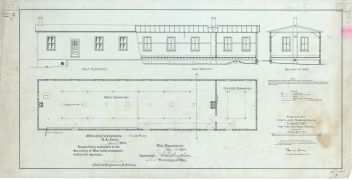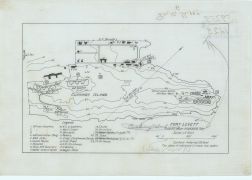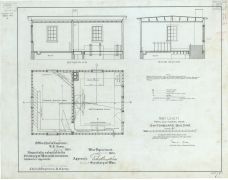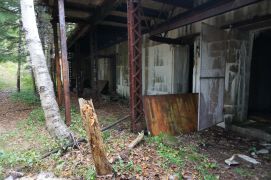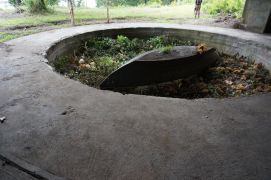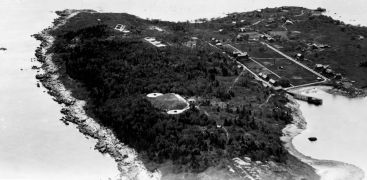Fort Levett: Difference between revisions
J. Malcolm (talk | contribs) |
J. Malcolm (talk | contribs) m →WWI Era |
||
| Line 2: | Line 2: | ||
== Endicott Era == | == Endicott Era == | ||
In 1894 the government exercised its right to eminent domain and took control of the land from Francis Cushing. The initial parcel of land was 33.75 acres which was deemed too small for military use. In 1904 the reservation was increased by 91.68 acres bringing the total to 127 acres. The fort was officially named on April 4th, 1900, after Christopher Levett who explored Casco Bay in the 1620s and was designated a sub post of [[Fort Williams]]. No construction on any part of the fort would begin until 1897. Four batteries were planned for the site in 1898. Railroad beds, drains, concrete mixing wells and other necessary infrastructure were prepared for construction and completed by 1899. The concrete work was started in 1900 on Battery Bowdoin and Kendrick. A narrow-gauge railway was completed in 1899 that connected each of the batteries. On August 26-29 a mock battle was created to test how strong the Naval ships were and how strong the Coast Artillery Forts were. Fort Levett did take part in this experiment. In 1904 most all of the main post buildings were built. The central powerhouse was completed June 30th, 1905 for $52,600 along the parade ground with three Westinghouse 105 Horsepower steam engines that were purchased in 1903. This powerhouse would provide electricity for all of the tactical buildings at Fort Levett. Two 30-inch truck-mounted searchlights were transferred to Fort Levett on December 26th, 1905. On January 29th, 1909 a number of buildings were accepted for service including the switchboard building, dormitory, combined secondar station for [[Fort Williams]], Fire Command Positions and Base-End Stations for Batteries Chase, Bowdoin and Kendrick. Secondary Fire Control positions for Fort Levett were located in another stucco building at [[Fort Williams]]. On August 26th, 1909 another group of buildings were accepted for service including the district signal station, BC Stations for Batteries Bowdoin and Kendrick, the meteorological station and tide gauge station. In 1911 a brand-new searchlight powerhouse was built near whitehead to serve two 60-inch searchlights transferred April 28th, 1911. <gallery mode="packed"> | In 1894 the government exercised its right to eminent domain and took control of the land from Francis Cushing. The initial parcel of land was 33.75 acres which was deemed too small for military use. In 1904 the reservation was increased by 91.68 acres bringing the total to 127 acres. The fort was officially named on April 4th, 1900, after Christopher Levett who explored Casco Bay in the 1620s and was designated a sub post of [[Fort Williams]]. No construction on any part of the fort would begin until 1897. Four batteries were planned for the site in 1898. Railroad beds, drains, concrete mixing wells and other necessary infrastructure were prepared for construction and completed by 1899. The concrete work was started in 1900 on Battery Bowdoin and Kendrick. A narrow-gauge railway was completed in 1899 that connected each of the batteries. On August 26-29 a mock battle was created to test how strong the Naval ships were and how strong the Coast Artillery Forts were. Fort Levett did take part in this experiment. In 1904 most all of the main post buildings were built. The central powerhouse was completed June 30th, 1905 for $52,600 along the parade ground with three Westinghouse 105 Horsepower steam engines that were purchased in 1903. This powerhouse would provide electricity for all of the tactical buildings at Fort Levett. Two 30-inch truck-mounted searchlights were transferred to Fort Levett on December 26th, 1905. Fort Levett was not garrisoned until 1907 when the 1st Company Coast Artillery Corps (CAC) came to Portland. On January 29th, 1909 a number of buildings were accepted for service including the switchboard building, dormitory, combined secondar station for [[Fort Williams]], Fire Command Positions and Base-End Stations for Batteries Chase, Bowdoin and Kendrick. Secondary Fire Control positions for Fort Levett were located in another stucco building at [[Fort Williams]]. On August 26th, 1909 another group of buildings were accepted for service including the district signal station, BC Stations for Batteries Bowdoin and Kendrick, the meteorological station and tide gauge station. In 1911 a brand-new searchlight powerhouse was built near whitehead to serve two 60-inch searchlights transferred April 28th, 1911. <gallery mode="packed"> | ||
File:TempDorm.jpg|alt= | File:TempDorm.jpg|alt= | ||
File:QuadFCS.jpg|alt= | File:QuadFCS.jpg|alt= | ||
| Line 15: | Line 15: | ||
== Battery Bowdoin == | == Battery Bowdoin == | ||
Construction on this three-gun 12-inch disappearing battery started in 1899. Originally planned for four guns, only three emplacements were built. Emplacements #4 and #3 were completed in 1901 and emplacement #2 was completed in 1902. In 1902 it was decided to eliminate the fourth emplacement. Each emplacement was armed with M1897 disappearing carriages and M1895 12-inch rifles which were all installed by 1903. The battery was transferred for use on April 23rd, 1903 at a cost of $190,290.56. This battery was named in 1900 after James Bowdoin who was the governor of Massachusetts in the late 1700s. Three hodges back delivery hoists were installed originally but on April 15th, 1919 three new Taylor-Raymond back delivery hoists were installed in their place. In 1918 generators were installed to serve the battery and all of whitehead as auxiliary. <gallery mode="packed"> | Construction on this three-gun 12-inch disappearing battery started in 1899. Originally planned for four guns, only three emplacements were built. Emplacements #4 and #3 were completed in 1901 and emplacement #2 was completed in 1902. In 1902 it was decided to eliminate the fourth emplacement. Each emplacement was armed with M1897 disappearing carriages and M1895 12-inch rifles which were all installed by 1903. The battery was transferred for use on April 23rd, 1903 at a cost of $190,290.56. This battery was named in 1900 after James Bowdoin who was the governor of Massachusetts in the late 1700s. Three hodges back delivery hoists were installed originally but on April 15th, 1919 three new Taylor-Raymond back delivery hoists were installed in their place. In 1918 generators were installed to serve the battery and all of whitehead as auxiliary. In 1941 camouflage netting was installed over the battery and would remain in place until deactivation. On March 1st, 1944 Battery Bowdoin's guns were ordered salvaged but were not sent to Watervliet until January 15th, 1945. <gallery mode="packed"> | ||
File:BowdinPlan.jpg|alt= | File:BowdinPlan.jpg|alt= | ||
File:Fort Levett Batteries.jpg|alt= | File:Fort Levett Batteries.jpg|alt= | ||
| Line 24: | Line 24: | ||
== Battery Kendrick == | == Battery Kendrick == | ||
Construction on this two-gun 10-inch disappearing gun battery started in 1899 along with Battery Bowdin. Construction was mostly completed by 1901 and the battery was armed in 1902 and transferred into service on April 23rd, 1903 with two M1895 10-inch rifles on M1896 disappearing carriages for $118,578.20. This battery was named in honor of Henry Lane Kendrick who was a science professor. Two Hodges back delivery hoists were provided | Construction on this two-gun 10-inch disappearing gun battery started in 1899 along with Battery Bowdin. Construction was mostly completed by 1901 and the battery was armed in 1902 and transferred into service on April 23rd, 1903 with two M1895 10-inch rifles on M1896 disappearing carriages for $118,578.20. This battery was named in honor of Henry Lane Kendrick who was a science professor. Two Hodges back delivery hoists were provided. Type-C powder hoists were accepted for service October 14th, 1912. When Battery Ferguson was planned, it was to be adjacent to this battery which resulted in the widening of Battery Kendrick's loading platforms where emplacement #1 met Battery Ferguson. On August 24th, 1917 the two guns were dismounted to be sent abroad. Instead, they just sat at the wharf until the war ended when they were remounted. In 1918 generators were installed to serve Battery Ferguson and Daniels along with the Fire Command group as auxiliary. In 1919 the original Hodges shell hoists were replaced with Taylor Raymond Hoists. Battery Kendrick remained in service until 1932 when it was put in reduced maintenance status essentially eliminating it from the Harbor Defenses. On November 6th, 1942 Battery Kendrick was declared surplus and on December 15th its guns and carriages were ordered salavged. <gallery mode="packed"> | ||
File:Fort Levetts 16.jpg|alt= | File:Fort Levetts 16.jpg|alt= | ||
File:KendrickPlan.jpg|alt= | File:KendrickPlan.jpg|alt= | ||
| Line 33: | Line 33: | ||
== Battery Ferguson == | == Battery Ferguson == | ||
Plans for this battery were created in 1901. Originally this battery was to hold four 6-inch guns mounted on pedestal mounts but during initial construction in 1902 this plan was altered to only have two guns per emplacement. The battery was named in 1903 after William Ferguson who served in the American Revolution. The battery was completed in 1904. In 1906 M1900 rifles and barbette mounts were installed on the battery, and it was transferred for use on June 22nd, 1906 for $58,500. Two Hodges back delivery hoists were provided. <gallery mode="packed"> | Plans for this battery were created in 1901. Originally this battery was to hold four 6-inch guns mounted on pedestal mounts but during initial construction in 1902 this plan was altered to only have two guns per emplacement. The battery was named in 1903 after William Ferguson who served in the American Revolution. The battery was completed in 1904. In 1906 M1900 rifles and barbette mounts were installed on the battery, and it was transferred for use on June 22nd, 1906 for $58,500. Two Hodges back delivery hoists were provided. In 1938 Battery Ferguson would be used to protect the minefield of Mines I. In 1940 plans to upgrade the battery included raising the existing gun platforms, installing splinter-proof shields on the guns and adding camouflage netting. This would all be completed by 1943. A fire control position would be located at [[Trundy Point MR]] to improve the range. A SCR 296 was also located at Whitehead for the battery. The guns were removed in 1947 and the battery was deactivated. <gallery mode="packed"> | ||
File:Fergusen1905plan.jpg|alt= | File:Fergusen1905plan.jpg|alt= | ||
File:Fort Levett Batteries.jpg|alt= | File:Fort Levett Batteries.jpg|alt= | ||
| Line 39: | Line 39: | ||
== Battery Daniels == | == Battery Daniels == | ||
Construction on this three-gun 3-inch rapid fire battery started in 1899. It was designed to protect and sweep the minefield. The battery was completed in 1900 and armed in 1901 with M1898 mounts and M1898 rifles. The battery was transferred April 23rd, 1903 for $14,994,18 after being named for Napoleon Daniels who served in the Civil War. In 1920 a program was started to remove all unnecessary small caliber guns. The guns of Battery Daniels were removed, and the mounts salvaged. | Construction on this three-gun 3-inch rapid fire battery started in 1899. It was designed to protect and sweep the minefield. The battery was completed in 1900 and armed in 1901 with M1898 mounts and M1898 rifles. The battery was transferred April 23rd, 1903 for $14,994,18 after being named for Napoleon Daniels who served in the Civil War. In 1920 a program was started to remove all unnecessary small caliber guns. The guns of Battery Daniels were removed, and the mounts salvaged on March 27th, 1920. | ||
== WWI Era == | == WWI Era and Interwar == | ||
<gallery mode="packed"> | In 1914 the 50th Company CAC was moved from [[Fort McKinley]] to Levett. In 1920 an Anti-Aircraft Battery of two 3-inch guns was built. In 1917 the 9th, 22nd and 23rd companies of the Coast Defenses of Portland were assigned to Fort Levett. Maine National Guard CAC would be stationed at the fort in the 1920s. In 1932 a third gun was added to the Anti-Aircraft Battery along with .50 Anti Air Machine Guns and a 60-inch AA Sperry Searchlight.<gallery mode="packed"> | ||
File:1918Switchboardbldg.jpg|alt= | File:1918Switchboardbldg.jpg|alt= | ||
File:Fort Levett Plan.jpg|alt= | File:Fort Levett Plan.jpg|alt= | ||
| Line 48: | Line 48: | ||
== Battery Foote == | == Battery Foote == | ||
Construction was authorized in 1917 for a new long range 12" gun battery. Initially, two batteries were planned for the site but the second was eliminated before construction could begin. This battery was completed January 26th, 1921 and named in honor of Stephen M Foote<gallery mode="packed"> | Construction was authorized in 1917 for a new long range 12" gun battery. Initially, two batteries were planned for the site but the second was eliminated before construction could begin. The estimated cost for the battery was $149,415 which included the carriages but $236,000 was allotted. It would cost another $10,000 to install the guns which were model M1895A4 on M1917A2 Long range barbette carriages. The weapons were installed and ready for action on December 17th, 1920. The arc of range was originally about 17 miles in all directions. This battery was completed January 26th, 1921 and named in honor of Stephen M Foote who was in the CAC. The two gun emplacements were 320 feet apart with a central magazine in the middle. A power room was built in the middle of the central magazine. Two fire control positions with open roofs could be accessed via two staircases along the central traverse. In 1922 property was acquired on [[Jewell Island MR]] and [[Trundy Point MR]] for fire control stations. A steel tower would be built at Trundy Point and a one room concrete building would be built on Jewell Island which would be replaced in the 1930s by a castle-like station. In the 1940 modernization plan, Battery Foote was selected to be casemented for protection against air attack. This upgrade would be completed in July 1943 and additional fire control positions would be added for increased range. WWII Fire Control Stations for Battery Foote would be located at [[Fletchers Neck MR]], [[Prouts Neck MR]], [[Trundy Point MR]], [[Jewell Island MR]] and [[Bailey Island MR]]. A SCR 296 would be located at Dyer Point in [[Cape Elizabeth MR]] for the battery. <gallery mode="packed"> | ||
File:Fort Levetts 12.jpg|alt= | File:Fort Levetts 12.jpg|alt= | ||
File:Fort Levetts 11.jpg|alt= | File:Fort Levetts 11.jpg|alt= | ||
| Line 61: | Line 61: | ||
== WWII Era == | == WWII Era == | ||
On September 16th, 1940 Fort Levett was manned by the 1st Battalion 240th Coast Artillery under Colonel Fogg. Battery A would service Battery Foote, Battery B would service Battery Bowdoin and Battery C would service Battery Ferguson, Battery G would service the AA guns. Upgrades would be made to Batteries Bowdoin and Ferguson to improve them for war. Test firings were completed in 1941. Additional construction would take place on Fire Control Structures and Battery Foote from 1942-44. | |||
== Battery AMTB 962 == | == Battery AMTB 962 == | ||
AMTB #2 was constructed in 1942 and built 40ft above sea level. It covered the interior of the main shipping channel. Ammunition and powder was stored in the defunct Battery Daniels and the wooden BC Station was built inside one of the emplacements where it remained until 1987 when it was blown over. This battery was deactivated in 1946 but its guns may have been stored away earlier. | |||
=== WWII FIRE CONTROL STATIONS & RADARS === | === WWII FIRE CONTROL STATIONS & RADARS === | ||
| Line 71: | Line 73: | ||
==== Site 1G SCR 296-3 (Radar) ==== | ==== Site 1G SCR 296-3 (Radar) ==== | ||
Built in 1943 atop a 100ft steel girder tower this radar served Battery Ferguson. A concrete block operations building and generator buildings (25kw generators) were located at the base of the tower. In 1948 the radar and tower were removed for scrap. The concrete block operations building remains, although the roof is missing. Of the two generator buildings neither were found upon inspection. | |||
==== Site 1H Fire Control Tower ==== | ==== Site 1H Fire Control Tower ==== | ||
This 8-story tower was built in 1942 and served (all DPF) Battery 202 at [[Jewell Island MR]], Battery Carpenter at [[Fort McKinley]] and Gun-Group Five (G-5) which comprised of the AMTB batteries 961 at [[Fort Williams]], 962 at [[Fort Levett]], 963 at [[Peaks Island MR]], Battery Mason at [[Fort Preble]] and Battery Keyes at [[Fort Williams]]. The command post for G-5 was either located on the sixth floor of the tower or the first floor. A unique Anti-Aircraft crow's nest was built on the top floor of the tower hanging off the back instead of being concealed within the structure. | |||
==== Site 1J Gun-Group Command Post ==== | ==== Site 1J Gun-Group Command Post ==== | ||
This station was built in 1942 and was the gun-group one combined observation post and command post. Gun-Group 1 was comprised of the primary batteries at Fort Levett (Foote and Ferguson). This Groupement would switch around over the course of the war depending on what batteries were active at which forts. From January 1944 to 1945 G-1 consisted of Battery Foote and Steele. | |||
== Present == | == Present == | ||
Revision as of 19:53, 27 May 2024
Fort Levett is a former Coastal Defense site established in 1894 on Cushings Island in Casco Bay. The fort was used through WWII and abandoned shortly after. Location 161.
Endicott Era
In 1894 the government exercised its right to eminent domain and took control of the land from Francis Cushing. The initial parcel of land was 33.75 acres which was deemed too small for military use. In 1904 the reservation was increased by 91.68 acres bringing the total to 127 acres. The fort was officially named on April 4th, 1900, after Christopher Levett who explored Casco Bay in the 1620s and was designated a sub post of Fort Williams. No construction on any part of the fort would begin until 1897. Four batteries were planned for the site in 1898. Railroad beds, drains, concrete mixing wells and other necessary infrastructure were prepared for construction and completed by 1899. The concrete work was started in 1900 on Battery Bowdoin and Kendrick. A narrow-gauge railway was completed in 1899 that connected each of the batteries. On August 26-29 a mock battle was created to test how strong the Naval ships were and how strong the Coast Artillery Forts were. Fort Levett did take part in this experiment. In 1904 most all of the main post buildings were built. The central powerhouse was completed June 30th, 1905 for $52,600 along the parade ground with three Westinghouse 105 Horsepower steam engines that were purchased in 1903. This powerhouse would provide electricity for all of the tactical buildings at Fort Levett. Two 30-inch truck-mounted searchlights were transferred to Fort Levett on December 26th, 1905. Fort Levett was not garrisoned until 1907 when the 1st Company Coast Artillery Corps (CAC) came to Portland. On January 29th, 1909 a number of buildings were accepted for service including the switchboard building, dormitory, combined secondar station for Fort Williams, Fire Command Positions and Base-End Stations for Batteries Chase, Bowdoin and Kendrick. Secondary Fire Control positions for Fort Levett were located in another stucco building at Fort Williams. On August 26th, 1909 another group of buildings were accepted for service including the district signal station, BC Stations for Batteries Bowdoin and Kendrick, the meteorological station and tide gauge station. In 1911 a brand-new searchlight powerhouse was built near whitehead to serve two 60-inch searchlights transferred April 28th, 1911.
Battery Bowdoin
Construction on this three-gun 12-inch disappearing battery started in 1899. Originally planned for four guns, only three emplacements were built. Emplacements #4 and #3 were completed in 1901 and emplacement #2 was completed in 1902. In 1902 it was decided to eliminate the fourth emplacement. Each emplacement was armed with M1897 disappearing carriages and M1895 12-inch rifles which were all installed by 1903. The battery was transferred for use on April 23rd, 1903 at a cost of $190,290.56. This battery was named in 1900 after James Bowdoin who was the governor of Massachusetts in the late 1700s. Three hodges back delivery hoists were installed originally but on April 15th, 1919 three new Taylor-Raymond back delivery hoists were installed in their place. In 1918 generators were installed to serve the battery and all of whitehead as auxiliary. In 1941 camouflage netting was installed over the battery and would remain in place until deactivation. On March 1st, 1944 Battery Bowdoin's guns were ordered salvaged but were not sent to Watervliet until January 15th, 1945.
Battery Kendrick
Construction on this two-gun 10-inch disappearing gun battery started in 1899 along with Battery Bowdin. Construction was mostly completed by 1901 and the battery was armed in 1902 and transferred into service on April 23rd, 1903 with two M1895 10-inch rifles on M1896 disappearing carriages for $118,578.20. This battery was named in honor of Henry Lane Kendrick who was a science professor. Two Hodges back delivery hoists were provided. Type-C powder hoists were accepted for service October 14th, 1912. When Battery Ferguson was planned, it was to be adjacent to this battery which resulted in the widening of Battery Kendrick's loading platforms where emplacement #1 met Battery Ferguson. On August 24th, 1917 the two guns were dismounted to be sent abroad. Instead, they just sat at the wharf until the war ended when they were remounted. In 1918 generators were installed to serve Battery Ferguson and Daniels along with the Fire Command group as auxiliary. In 1919 the original Hodges shell hoists were replaced with Taylor Raymond Hoists. Battery Kendrick remained in service until 1932 when it was put in reduced maintenance status essentially eliminating it from the Harbor Defenses. On November 6th, 1942 Battery Kendrick was declared surplus and on December 15th its guns and carriages were ordered salavged.
(Powder hoists installed in 1912-Type C)
Battery Ferguson
Plans for this battery were created in 1901. Originally this battery was to hold four 6-inch guns mounted on pedestal mounts but during initial construction in 1902 this plan was altered to only have two guns per emplacement. The battery was named in 1903 after William Ferguson who served in the American Revolution. The battery was completed in 1904. In 1906 M1900 rifles and barbette mounts were installed on the battery, and it was transferred for use on June 22nd, 1906 for $58,500. Two Hodges back delivery hoists were provided. In 1938 Battery Ferguson would be used to protect the minefield of Mines I. In 1940 plans to upgrade the battery included raising the existing gun platforms, installing splinter-proof shields on the guns and adding camouflage netting. This would all be completed by 1943. A fire control position would be located at Trundy Point MR to improve the range. A SCR 296 was also located at Whitehead for the battery. The guns were removed in 1947 and the battery was deactivated.
Battery Daniels
Construction on this three-gun 3-inch rapid fire battery started in 1899. It was designed to protect and sweep the minefield. The battery was completed in 1900 and armed in 1901 with M1898 mounts and M1898 rifles. The battery was transferred April 23rd, 1903 for $14,994,18 after being named for Napoleon Daniels who served in the Civil War. In 1920 a program was started to remove all unnecessary small caliber guns. The guns of Battery Daniels were removed, and the mounts salvaged on March 27th, 1920.
WWI Era and Interwar
In 1914 the 50th Company CAC was moved from Fort McKinley to Levett. In 1920 an Anti-Aircraft Battery of two 3-inch guns was built. In 1917 the 9th, 22nd and 23rd companies of the Coast Defenses of Portland were assigned to Fort Levett. Maine National Guard CAC would be stationed at the fort in the 1920s. In 1932 a third gun was added to the Anti-Aircraft Battery along with .50 Anti Air Machine Guns and a 60-inch AA Sperry Searchlight.
Battery Foote
Construction was authorized in 1917 for a new long range 12" gun battery. Initially, two batteries were planned for the site but the second was eliminated before construction could begin. The estimated cost for the battery was $149,415 which included the carriages but $236,000 was allotted. It would cost another $10,000 to install the guns which were model M1895A4 on M1917A2 Long range barbette carriages. The weapons were installed and ready for action on December 17th, 1920. The arc of range was originally about 17 miles in all directions. This battery was completed January 26th, 1921 and named in honor of Stephen M Foote who was in the CAC. The two gun emplacements were 320 feet apart with a central magazine in the middle. A power room was built in the middle of the central magazine. Two fire control positions with open roofs could be accessed via two staircases along the central traverse. In 1922 property was acquired on Jewell Island MR and Trundy Point MR for fire control stations. A steel tower would be built at Trundy Point and a one room concrete building would be built on Jewell Island which would be replaced in the 1930s by a castle-like station. In the 1940 modernization plan, Battery Foote was selected to be casemented for protection against air attack. This upgrade would be completed in July 1943 and additional fire control positions would be added for increased range. WWII Fire Control Stations for Battery Foote would be located at Fletchers Neck MR, Prouts Neck MR, Trundy Point MR, Jewell Island MR and Bailey Island MR. A SCR 296 would be located at Dyer Point in Cape Elizabeth MR for the battery.
WWII Era
On September 16th, 1940 Fort Levett was manned by the 1st Battalion 240th Coast Artillery under Colonel Fogg. Battery A would service Battery Foote, Battery B would service Battery Bowdoin and Battery C would service Battery Ferguson, Battery G would service the AA guns. Upgrades would be made to Batteries Bowdoin and Ferguson to improve them for war. Test firings were completed in 1941. Additional construction would take place on Fire Control Structures and Battery Foote from 1942-44.
Battery AMTB 962
AMTB #2 was constructed in 1942 and built 40ft above sea level. It covered the interior of the main shipping channel. Ammunition and powder was stored in the defunct Battery Daniels and the wooden BC Station was built inside one of the emplacements where it remained until 1987 when it was blown over. This battery was deactivated in 1946 but its guns may have been stored away earlier.
WWII FIRE CONTROL STATIONS & RADARS
Site 1B Mine Observation Station
Site 1E Fire Control Tower
Site 1G SCR 296-3 (Radar)
Built in 1943 atop a 100ft steel girder tower this radar served Battery Ferguson. A concrete block operations building and generator buildings (25kw generators) were located at the base of the tower. In 1948 the radar and tower were removed for scrap. The concrete block operations building remains, although the roof is missing. Of the two generator buildings neither were found upon inspection.
Site 1H Fire Control Tower
This 8-story tower was built in 1942 and served (all DPF) Battery 202 at Jewell Island MR, Battery Carpenter at Fort McKinley and Gun-Group Five (G-5) which comprised of the AMTB batteries 961 at Fort Williams, 962 at Fort Levett, 963 at Peaks Island MR, Battery Mason at Fort Preble and Battery Keyes at Fort Williams. The command post for G-5 was either located on the sixth floor of the tower or the first floor. A unique Anti-Aircraft crow's nest was built on the top floor of the tower hanging off the back instead of being concealed within the structure.
Site 1J Gun-Group Command Post
This station was built in 1942 and was the gun-group one combined observation post and command post. Gun-Group 1 was comprised of the primary batteries at Fort Levett (Foote and Ferguson). This Groupement would switch around over the course of the war depending on what batteries were active at which forts. From January 1944 to 1945 G-1 consisted of Battery Foote and Steele.
Present
Privately owned since 1957
SOURCES and REFERENCES
Battery Foote=Battery #4
Battery Ferguson=Battery #3
Battery Foote used for storing banks records.
Whiteheads FCS razed 1960s
Officers Duplex burned after 1970
Barracks burned 1970
